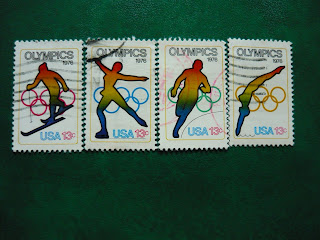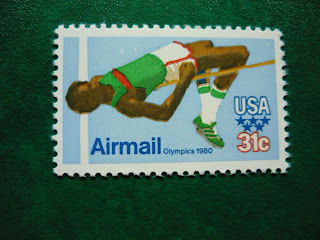
Thursday, July 30, 2009
Sunday, July 26, 2009
North American Olympic issues -updated
1996- Olympic Games Centennial

1992 Barcelona: 1 stamp from the set of 5:

1980: Lake Placid

1976: Innsbruck

1990 Olympic Games Winners

1972 Sapporo and Munich: 3 out of 4

1976 Innsbruck and Montreal:

1980: Moskow
a. first issue:

b. second issue: 3 stamps out of 4:


c. third issue:

1984 Sarajevo:

1988: Calgary

Seul:

1992: Alberville 4 out of 5:

Barcelona:
first issue: one stamp from the set of 5:

second issue: Baseball- olympic sport:

third issue: 1 stamp from the set of 4

1994: Lillehamer one stamp from the set of 5:

2004: Athens:

Wednesday, July 22, 2009
European Summer Olympic Games Issues
Anyway the section will be under construction permanently.
1964- Tokyo
1.Monaco 1 stamp from the set of 5:

1968- Mexico
1. Bulgaria- 5 stamps from the set of six:

1976- Montreal
1. Bulgaria-complete set:

2. Germany(Federal Republic) s/s:

3. Spain: 1 stamp from a set of 4:

1992- Barcelona:
1. Moldova Games issue and Medals issue


1. Ukraine- set of 3:

1996- Atlanta
1. Germany- full set:

2. Ukraine- set of 2 and s.s:

Monday, July 20, 2009
Art on stamps.
Baron Samuel von Brukenthal (1721-1803) was the only representative of the Transylvanian Saxon community who acceded to high public office in the Austrian Empire under the Empress Maria Theresia (1717 – 1780), the first such office being that of Chancellor of Transylvania.
The years spent in Vienna, in this capacity, were the years when the Baron started acquiring his collection of paintings, mentioned in Almanach de Vienne (1773) as being one of the most valuable private collections and generally admired by the cultivated Vienna public of the time.
Baron’s initial collections (comprising the collection of paintings, a collection of prints, a library and a coin collection) were mostly put together in the period between 1759 and 1774. We have scant information as to how they came into being, the earliest records in the Brukenthal family being the archive concerning acquisition of paintings dating from 1770 (by which time the core of the collection of paintings must have been acquired).
Appointed Governor of the Principality of Transylvania, a position that he occupied between 1777 and 1787, Samuel von Brukenthal built a Late Baroque palace in Sibiu, modelled on the palaces in the imperial capital.
2. Romania 1967- Paintings from the National Art Gallery(9.5 E)

The sets presents 6 other paintings, the last two being the most famous: Rubens- The Fight of Hercules with the Lion of Nemeea and Rembrandt: Haman Begging the Mercy of Esther.
You can have a closer look to these paintings at: http://www.mnar.arts.ro/EN_home.php
Sunday, July 19, 2009
Manuc's Inn

The inn was built in 1808, and originally owned by a wealthy and flamboyant Armenian, Emanuel Mârzaian, better known as Manuc-bei. Manuc is not a Turkish name(as I thought), but it is formed from Armenian word “Manuc + bei”.In Armenian language Manuc's meaning is “child” for example “Manuci zhepit” (child’s smile),
Manuc is original Armenian male first name.Also “bei” or “beyg” this was aristocratic title in Moslem countries.
Although Manuc's
The inn was the site of the preliminary talks for the Treaty of Bucharest, which put an end to the 1806–1812 Russian-Turkish war. In 1842 it briefly housed
Before Romania entered World War I, in 1914–1916, the hall "Sala Dacia" hosted meetings of the Wallachian pro-war party seeking to establish a Greater Romania by uniting the Kingdom of Romania with Transylvania and Bukovina.
There is also a folk song about this place. Even though it is in Romanian I hope you would like it.
Folklore around the world
























